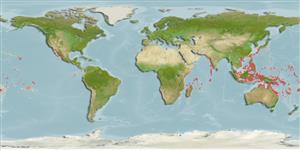Malacostraca |
Decapoda |
Xanthidae
Environment: milieu / climate zone / depth range / distribution range
Ecology
Reef-associated; depth range 0 - 6 m (Ref. 96667). Tropical
Indo-Pacific.
Length at first maturity / Size / Weight / Age
Maturity: Lm ? range ? - ? cm
Small carapace has distinctly rough surface due to small granules with fine hairs as cover. Pair of pincers are unequal and covered also with very tiny granules (Ref. 128968).
May contain toxins that are undectectable in tests, and thus, may not be safe to eat (Ref. 128968). Intertidal to subtidal (Ref. 106854). Found on the reef between tide marks (Ref. 81564).
Life cycle and mating behavior
Maturity | Reproduction | Spawning | Eggs | Fecundity | Larvae
Members of the order Decapoda are mostly gonochoric. Mating behavior: Precopulatory courtship ritual is common (through olfactory and tactile cues); usually indirect sperm transfer.
Ward, M. 1941. (Ref. 2897)
IUCN Red List Status (Ref. 130435)
CITES status (Ref. 108899)
Not Evaluated
Not Evaluated
Threat to humans
Poisonous to eat (Ref. 128968)
Human uses
| FishSource |
Tools
More information
Age/SizeGrowthLength-weightLength-lengthMorphologyLarvaeAbundance
Internet sources
Estimates based on models
Preferred temperature
(Ref.
115969): 24.7 - 29.2, mean 28.2 (based on 2671 cells).
Price category
Unknown.
